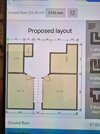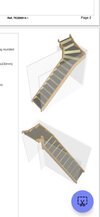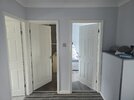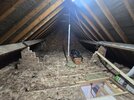Planning on a loft conversion, it might take me a year or 5 to complete but I want to do the work myself, I enjoy building/making stuff and obviously it'll be cheaper than getting a
builder in to do it.
I want to do it properly with building regulations all correct and signed off etc. Seems a bit of a minefield.
Can anyone recommend any sources that go into all of the current regs and requirements etc?
A mate told me just to contact my local building control at the council and ask for advice but will they actually be helpful or just treat me as another idiot who wants to bodge a loft conversion?
I've done a plan of what I want would appreciate any input on the basic concept.
Pics show the current condition and what I plan. Stairs in the plan are not quite right, pic included of actual stairs I was thinking of using.
The house is a semi, so I'll need to sort out the party wall agreement with the neighbour. Plan is to attach a joist to the wall then span joists from that across to the wall that is supporting the purlins shown, 3.7m. Then do the same for
the other side which is 3.1m. Was looking to use C24 63x170 joists.
Input welcome
builder in to do it.
I want to do it properly with building regulations all correct and signed off etc. Seems a bit of a minefield.
Can anyone recommend any sources that go into all of the current regs and requirements etc?
A mate told me just to contact my local building control at the council and ask for advice but will they actually be helpful or just treat me as another idiot who wants to bodge a loft conversion?
I've done a plan of what I want would appreciate any input on the basic concept.
Pics show the current condition and what I plan. Stairs in the plan are not quite right, pic included of actual stairs I was thinking of using.
The house is a semi, so I'll need to sort out the party wall agreement with the neighbour. Plan is to attach a joist to the wall then span joists from that across to the wall that is supporting the purlins shown, 3.7m. Then do the same for
the other side which is 3.1m. Was looking to use C24 63x170 joists.
Input welcome
Attachments
-
 RDT_20240806_1927172227291974277877418.png1.7 MB · Views: 87
RDT_20240806_1927172227291974277877418.png1.7 MB · Views: 87 -
 IMG-20240806-WA0001.jpg290.5 KB · Views: 82
IMG-20240806-WA0001.jpg290.5 KB · Views: 82 -
 IMG-20240806-WA0004.jpg327.5 KB · Views: 74
IMG-20240806-WA0004.jpg327.5 KB · Views: 74 -
 IMG-20240806-WA0002.jpg256.1 KB · Views: 74
IMG-20240806-WA0002.jpg256.1 KB · Views: 74 -
 Screenshot_20240806_184521_Gallery.jpg59.7 KB · Views: 80
Screenshot_20240806_184521_Gallery.jpg59.7 KB · Views: 80 -
 20240803_134550.jpg189.7 KB · Views: 89
20240803_134550.jpg189.7 KB · Views: 89 -
 20240803_131026.jpg446.7 KB · Views: 83
20240803_131026.jpg446.7 KB · Views: 83

